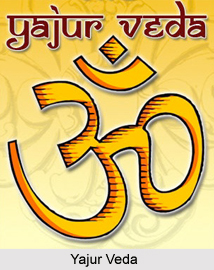 Yajur Veda is one of the four great works of ancient Indian literature. The Yajur Veda Samhitas are prayer books for the Adhvaryu priest. It is believed to have been composed between 1,400 and 1000 BCE. The Yajur Veda contains the liturgy or the mantras and the details of their performance in the Vedic period. A number of different schools of this Veda existed.
Yajur Veda is one of the four great works of ancient Indian literature. The Yajur Veda Samhitas are prayer books for the Adhvaryu priest. It is believed to have been composed between 1,400 and 1000 BCE. The Yajur Veda contains the liturgy or the mantras and the details of their performance in the Vedic period. A number of different schools of this Veda existed.
Samhitas of Yajur Veda
The least deviation in the ceremonies or in the liturgy was sufficient cause for the formation of a new Vedic school. Up to the present, five Samhitas and schools of the Yajur Veda are known to have existed. These are the Kathaka, the Yajur Veda Samhita in the recension of the Katha-school; the Kapisthala Katha Samhita, which is preserved only is a few fragments of manuscript; the Maitrayani Samhita, i.e. the Yajur Veda. Sainhita in the recension of the Maitrayaniya school; the Taittiriya Samhita, i.e. the Yajur Veda Samhita in the recension of the Taittirlya school, also called "Apastamba-Samhita" after the Apastamba-school, one of the chief schools in which this text was taught. These four recensions are closely inter-related, and are designated as belonging to the "Black Yajur Veda." Differing from them is the Vajasaneyi Samhita or the Samhita of the "White Yajur Veda" which takes its name from Yajnavalkya Vajasaneya, the chief teacher of this Veda. Of this Vajasaneyi Samhita there are two recensions, that of the Kanva and that of the Madhyandina School, which however differ very little from each other.
Composition of Yajur Veda
The Samhitas of Yajur Veda is divided into two parts: Shukla or white Yajur Veda and Krishna or black Yajur Veda. Shukla Yajur Veda has a separate Brahmana text written as Shatapatha Brahmana whereas the Krishna Yajur Veda has the Brahmana prose discussions.
Shukla Yajur Veda is divided into two parts. One is Vajasaneyi Madhyandiniya and the other is the Vajasaneyi Kanva. Both are known as Vajasaneyi Samhita. Vajasaneyi Madhyandiniya is popular in North India, northern parts Nasik of Maharashtra and Gujarat whereas, Vajasaneyi Kanva is popular in southern parts of Nasik, Andhra Pradesh, Orissa, Tamil Nadu and Karnataka. The chief difference between Samhitas of the "black" and the "white" Yajur Veda lies in the fact that the Vajasaneyi Samhita contains only the Mantras, i.e., the prayers and sacrificial formulae which the priest has to utter while the Samhitas of the Black Yajur Veda, besides the Mantras, contain a presentation of the sacrificial rites belonging to them, as well as discussions on the same.
Krishna Yajur Veda is divided into four parts. They are: Taittiriya Samhita, Maitrayani Samhita, Caraka Katha Samhita and the last one is Kapisthala Katha Samhita. All these parts are associated with a Brahmana that explains about Panchala, area of Kurukshetra and the parts of southern Punjab respectively.
The Taittiriya Samhita or Taittiriya Shakha is considered as to be the best known and best preserved portions of Yajur Veda. It consists of 7 books that are again subdivided in chapters. These subdivided chapters are further subdivided into individual sections known as Anuvakas.
Content of Yajur Veda
There are two major sacrifices present in Yajur Veda. They are Darsapurnamasa and Asvamedha or the horse-sacrifice. Darsapurnamasa is performed at new and full moon and in Asvamedha process 609 animals of various descriptions, domestic and wild, were tied to 21 sacrificial posts.
Some individual hymns in this Samhita are very popular in Hinduism. The Taittiriya Samhita of the Krishna Yajur Veda is the most popular Shakha in South India. According to Hindu mythology, it is believed that Vaisampayana, the disciple of Ved Vyas had received Yajur Veda from him. Once he committed an offence and uttered some nuisance on Yajnavalkya, the other disciple. As a result Yajnavalkya poured out all Yajus texts he had learned from Vaisampayan. The other disciples picked up these tainted texts, and retained them as Taittiriyas. But Yajnavalkya, prayed to the Sun to obtain the other Yajur texts, and had granted the wish - `to have all texts that were not known to his teacher. ` The Vajasaneyi Samhita in Yajur Veda has forty chapters along with their formulas used in the rituals. Few of the rituals of the Samhita are New and Full Moon sacrifices, Somayajna, Agnihotra, Rajasuya and Vajapeya. Sautramani is a ritual present in this Samhita is preventing the effects of excessive Soma-drinking. Its final chapter is the famous Isa Upanishad. The first volume of Taittiriya Samhita of Yajur Veda coupled with the commentary of Sayana or Madhava was first published in Bibliotheca Indica, in the period of 1860- 1865 by Baboo Rajendralala Mitra of Kolkata.
Some if the hymns of the Yajur Veda, such as the Gayatri Mantra, are popular to this day.













